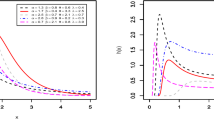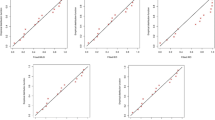Abstract
This article addresses the problem of deriving the explicit expressions for single and product moments of order statistics, generalized order statistics and dual generalized order statistics from the generalized Lindley distribution. The means and variances of order statistics, lower record values and progressively type-II censored order statistics for various values of the parameters are tabulated. Furthermore, the maximum likelihood estimators for the parameters of the model using generalized order statistics are obtained. The Bayes estimators under squared error and LINEX (Linear exponential) loss functions using Markov Chain Monte Carlo (MCMC) technique are obtained. Finally, three real data examples to lower record values, type-II censored and progressively type-II censored order statistics have been analyzed for illustrative purposes.








Similar content being viewed by others
References
Aboeleneen, Z.A.: Inference forWeibull distribution under generalized order statistics. Math. Comput. Simul. 81, 26–36 (2010)
Abu Elfotouh, S., Nassar, M.M.A.: Estimation for the parameters of the Weibull extension model based on generalized order statistics. Int. J. Contemp. Mathe. Sci. 6, 1749–1760 (2011)
Arnold, B.C., Balakrishnan, N., Nagaraja, H.N.: A First Course in Order Statistics. Wiley, New York (2003)
Balakrishnan, N., Joshi, P.C.: Moments of order statistics from doubly truncated Pareto distribution. J. Indian Stat. Assoc. 20, 109–117 (1982)
Balakrishnan, N., Malik, H.J.: Some general identities involving order statistics. Commun. Stat. Theory Methods 14, 333–339 (1985)
Balakrishnan, N., Malik, H.J., Ahmed, S.E.: Recurrence relations and identities for moments of order statistics, II: specific continuous distributions. Commun. Stat. Theory Methods 17, 2657–2694 (1988)
Bakouch, H., Al-Zahrani, B., Al-Shomrani, A., Marchi, V., Louzada, F.: An extended lindley distribution. J. Korean Stat. Soc. 41(1), 75–85 (2012)
Barnett, V., Lewis, T.: Outlier in Statistical Data, 3rd edn. Wiley, Chichester, England (1994)
Burkschat, M., Cramer, E., Kamps, U.: Dual generalized order statistics, pp. 13–26. Metron, LXI (2003)
David, H.A.: Order Statistics, 2nd edn. John, New York (1981)
David, H.A., Nagaraja, H.N.: Order Statistics, 3rd edn. Wiley, New York (2003)
Ghitany, M., Al-Mutairi, D., Nadarajah, S.: Zero-truncated Poisson–Lindley distribution and its application. Math. Comput. Simul. 79(3), 279–287 (2008)
Ghitany, M., Atieh, B., Nadarajah, S.: Lindley distribution and its application. Math. Comput. Simul. 78(4), 493–506 (2008)
Ghitany, M., Al-Mutairi, D., Balakrishnan, N., Al-Enezi, L.: Power Lindley distribution and associated inference. Comput. Stat. Data Anal. 64, 20–33 (2013)
Gradshteyn, I.S., Ryzhik, I.M.: Tables of Integrals, Series and Products, 8th edn. Academic Press, New York (2000)
Jaheen, Z.F.: Estimation based on generalized order statistics from the Burr model. Commun. Stat. Theory Methods 34, 785794 (2005)
Joshi, P.C.: Recurrence relations between moments of order statistics from exponential and truncated exponential distributions. Sankhya, B 39, 362–371 (1978)
Kamps, U.: A Concept of Generalized Order Statistics. B.G. Teubner, Stuttgart (1995)
Khan, M.A.R., Khan, R.U., Singh, B.: Moments of dual generalized order statistics from two parameter Kappa distribution and associated inference. J. Appl. Probab. Stat. 14, 85–101 (2019)
Kim, C., Han, K.: Bayesian estimation of Rayleigh distribution based on generalized order statistics. Appl. Math. Sci. 8, 7475–7485 (2014)
Kumar, D.: The extended generalized half logistic distribution based on ordered random variables. Tamkang J. Math. 46, 245–256 (2015a)
Kumar, D.: Exact moments of generalized order statistics from type II exponentiated log-logistic distribution. Hacettepe J. Math. Stat. 44, 715–733 (2015b)
Kumar, D., Dey, S., Nadarajah, S.: Extended exponential distribution based on order statistics. Commun. Stat. Theory Methods 46, 9166–9184 (2017)
Kumar, D., Goyal, A.: Generalized Lindley distribution based on order statistics and associated inference with application. Ann. Data Sci. 6, 707–736 (2019)
Kundu, D., Howlader, H.: Bayesian inference and prediction of the inverse Weibull distribution for Type-II censored data. Comput. Stat. Data Anal. 54(6), 1547–1558 (2010)
Lindley, D.: Fiducial distributions and bayes theorem. J. R. Statist. Soc. Ser. B 20, 102–107 (1958)
Mabrouk, Iman S.: Statistical analysis for an imprecise flood dataset using the generalized inverse Lindley distribution. Int. J. Contemp. Math. Sci. 14(4), 163–177 (2019)
Malik, H.J., Balakrishnan, N., Ahmed, S.E.: Recurrence relations and identities for moments of order statistics, I: arbitrary continuous distribution. Commun. Stat. Theory Methods 17, 2623–2655 (1988)
Malik, M.R., Kumar, D.: Generalized Pareto disatribution based on generalized order statistics ans associated inference. Stat. Trans New Ser.A 20(3), 57–79 (2019)
Mohie El-Din, M.M., Mahmoud, M.A.W., Abu-Youssef, S.E.: Moments of order statistics from parabolic and skewed distributions and characterization of Weibull distribution. Commun. Stat. Simul. Comput. 20, 639–645 (1991)
Nadarajah, S., Bakouch, H.S., Tahmasbi, R.: A generalized lindley distribution. Sankhya B 73(2), 331–359 (2011)
Safi, S.K., Ahmed, R.H.: Statistical estimation based on generalized order statistics from Kumaraswamy distribution. In: Proceeding of the 14st Applied Stochastic Models and Data Analysis (ASMDA)International Conference, Mataro (Barcelona), Spain, 25-28 (2013)
Sankaran, M.: The discrete Poisson–Lindley distribution. Biometrics 26(1), 145–149 (1970)
Shanker, R., Sharma, S., Shanker, R.: A two-parameter lindley distribution for modeling waiting and survival times data. Appl. Math. 4, 363–368 (2013)
Sharma, V.K., Singh, S.K., Singh, U., Merovci, F.: The generalized inverse Lindley distribution: a New inverse statistical model for the study of upside-down bathtub data. Commun. Stat. Theory Methods. 45(19), 5709–5729 (2016)
Singh, S.K., Singh, U., Sharma, V.K.: Bayesian prediction of future observations from inverse Weibull distribution based on Type-II hybrid censored sample. Int. J. Adv. Stat. Prob. 1, 32–43 (2013)
Singh, B., Khan, R.U., Khan, M.A.R.: Generalized order statistics from kumaraswamy Burr -III distribution and related inferences. J. Stat. 19, 1–16 (2018)
Zakerzadeh, H., Dolati, A.: Generalized lindley distribution. J. Math. Ext. 3(2), 13–25 (2009)
Acknowledgements
The authors would like to thank the Editor and anonymous referee for careful reading and for comments which substantially improved our manuscript.
Author information
Authors and Affiliations
Corresponding author
Additional information
Publisher's Note
Springer Nature remains neutral with regard to jurisdictional claims in published maps and institutional affiliations.
Appendix
Appendix
Lemma 1
Let f(x) and F(x) be given by (1) and (2), respectively. For \(a_{1} > 0\) and \(a_{2} > 0\), let
Then,
where \(\Gamma (\lambda )=\int _{0}^{\infty }z^{\lambda -1}~e^{-z}dz.\)
Proof
We can write
Using the binomial expression, the above can be rewritten as
\(\square \)
Lemma 2
For \(a_{1} > 0\), \(a_{2} > 0\), \(a_{3} > 0\) and \(a_{4} > 0\), let
Then,
where \({}_2 F_1(a,b;~c;~x)\) denotes the Gauss hypergeometric function defined by
where \((f)_{p}=f(f+1)\ldots (f+p-1)\) denotes the ascending factorial.
Proof
We can write
where we have set \(z=\frac{\eta (a_{2}+1)}{y^{\tau }}\) and \(\gamma (a_{1},x)=\int _{0}^{x}t^{a_{1}-1}exp(-t)dt\) denote the complementary incomplete gamma function. Hence,
Using the transformation \(t= \frac{\eta (a_{2}+1)}{x^{\tau }}\). The result follows by using equation (6.455.1) in Gradshteyn and Ryzhik (2014) to calculate the above integral. \(\square \)
Rights and permissions
About this article
Cite this article
Kumar, D., Nassar, M. & Dey, S. Inference for generalized inverse Lindley distribution based on generalized order statistics. Afr. Mat. 31, 1207–1235 (2020). https://doi.org/10.1007/s13370-020-00791-4
Received:
Accepted:
Published:
Issue Date:
DOI: https://doi.org/10.1007/s13370-020-00791-4
Keywords
- Generalized inverse Lindley distribution
- Order statistics
- Generalized order statistics
- Dual generalized order statistics
- Lower record values
- Progressively type-II censoring




